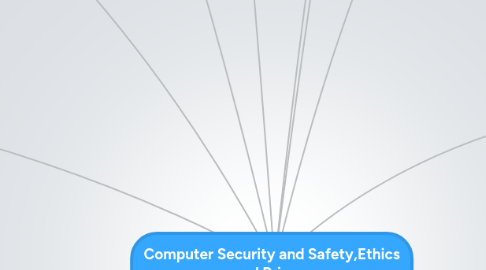Computer Security and Safety,Ethics and Privacy
by Adisak Autthaphaisal

1. Computer Security Risks
1.1. A computer security risk is any event or action that could cause a loss of or damage to computer hardware, software, data, information, or processing capability
1.2. A cybercrime is an online or Internet‐based illegal act
1.3. Hackers, Crackers ,Script Kiddies, Corporate Spies Unethical Employees,Cyberextortionists, Cyberterrorists
2. Internet and Network Attacks
2.1. Information transmitted over networks has a higher degree of security risk than information kept on an organization’s premises
2.2. An online security service is a Web site that evaluates your computer to check for Internet and e‐mail vulnerabilities
2.3. Users can take several precautions to protect their home and work computers and mobile devices from these malicious infections
2.4. A botnet is a group of compromised computers connected to a network – A compromised computer is known as a zombie
2.5. A denial of service attack (DoS attack) disrupts computer access to Internet services – Distributed DoS (DDoS)
2.6. A back door is a program or set of instructions in a program that allow users to bypass security controls
2.7. Spoofing is a technique intruders use to make their network or Internet transmission appear legitimate
2.8. A firewall is hardware and/or software that protects a network’s resources from intrusion
3. Unauthorized Access and Use
3.1. Organizations take several measures to help prevent unauthorized access and use – Acceptable use policy – Disable file and printer sharing – Firewalls – Intrusion detection software
3.2. Access controls define who can access a computer, when they can access it, and what actions they can take – Two‐phase processes called identification and authentication – User name – Password – CAPTCHA
3.3. A possessed object is any item that you must carry to gain access to a computer or computer facility – Often are used in combination with a personal identification number (PIN)
3.4. A biometric device authenticates a person’s identity by translating a personal characteristic into a digital code that is compared with a digital code in a computer
3.5. Digital forensics is the discovery, collection, and analysis of evidence found on computers and networks
4. Information Theft
4.1. Information theft occurs when someone steals personal or confidential information
4.2. Encryption is a process of converting readable data into unreadable characters to prevent unauthorized access
4.3. A digital signature is an encrypted code that a person, Web site, or organization attaches to an electronic message to verify the identity of the sender – Often used to ensure that an impostor is not participating in an Internet transaction
4.4. Web browsers and Web sites use encryption techniques
4.5. Popular security techniques include:Digital Certificates,Transport Layer Security (TLS),Secure HTTP,VPN
5. Health Concerns of Computer Use
5.1. The widespread use of computers has led to health concerns – Repetitive strain injury (RSI) – Carpal tunnel syndrome (CTS) – Computer vision syndrome (CVS)
5.2. Computer addiction occurs when the computer consumes someone’s entire social life
6. Hardware Theft and Vandalism
6.1. Hardware theft is the act of stealing computer equipment
6.2. Hardware vandalism is the act of defacing or destroying computer equipment
6.3. To help reduce the of chances of theft, companies and schools use a variety of security measures
7. Software Theft
7.1. Software theft occurs when someone:Steals software media,Intentionally erases programs,Illegally copies a program,Illegally registers and/or activates a program
7.2. A single‐user license agreement typically contains the following conditions: Permitted to • Install the software on one computer • Make one copy of the software • Remove the software from your computer before giving it away or selling it Not permitted to • Install the software on a network • Give copies to friends or colleagues while continuing to use the software • Export the software • Rent or lease the software
7.3. Copying, loaning,borrowing, renting, or distributing software can be a violation of copyright law
7.4. Some software requires product activation to function fully
8. System Failure
8.1. A system failure is the prolonged malfunction of a computer
8.2. A variety of factors can lead to system failure, including: – Aging hardware – Natural disasters – Electrical power problems • Noise, undervoltages, and overvoltages – Errors in computer programs
8.3. Two ways to protect from system failures caused by electrical power variations include surge protectors and uninterruptable power supplies (UPS)
9. Backing Up – The Ultimate Safeguard
9.1. • A backup is a duplicate of a file, program, or disk that can be used if the original is lost, damaged, or destroyed – To back up a file means to make a copy of it
9.2. Offsite backups are stored in a location separate from the computer site
9.3. Two categories of backups: – Full backup – Selective backup
9.4. Three‐generation backup policy Grandparent>Parent>Child
10. Wireless Security
10.1. Wireless access poses additional security risks – About 80 percent of wireless networks have no security protection
10.2. War driving allows individuals to detect wireless networks while driving a vehicle through the area
10.3. In additional to using firewalls, some safeguards improve security of wireless networks:A wireless access point should not broadcast an SSID,Change the default SSID
11. Ethics and Society
11.1. Computer ethics are the moral guidelines that govern the use of computers and information systems
11.2. Information accuracy is a concern – Not all information on the Web is correct
11.3. Green computing involves reducing the electricity and environmental waste while using a computer
11.4. Information privacy refers to the right of individuals and companies to deny or restrict the collection and use of information about them
11.5. Many companies today allow people to specify whether they want their personal information distributed
11.6. Spam is an unsolicited e‐mail message or newsgroup posting
11.7. E‐mail filtering blocks e‐mail messages from designated sources
11.8. Anti‐spam programs attempt to remove spam before it reaches your inbox


